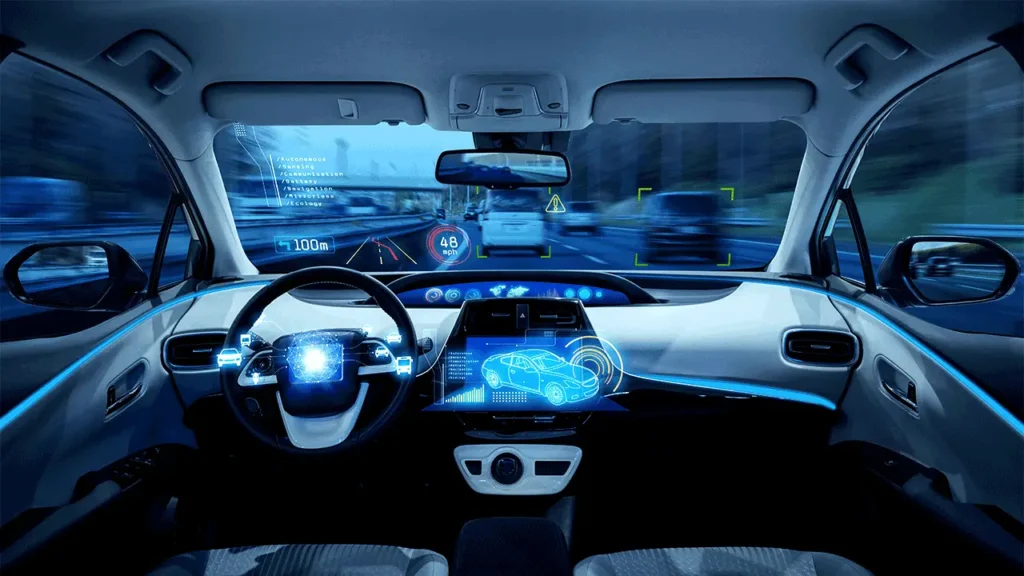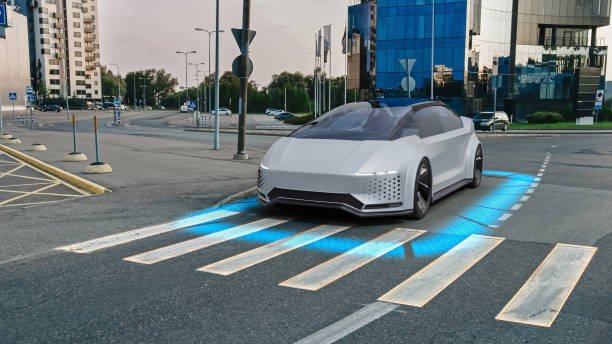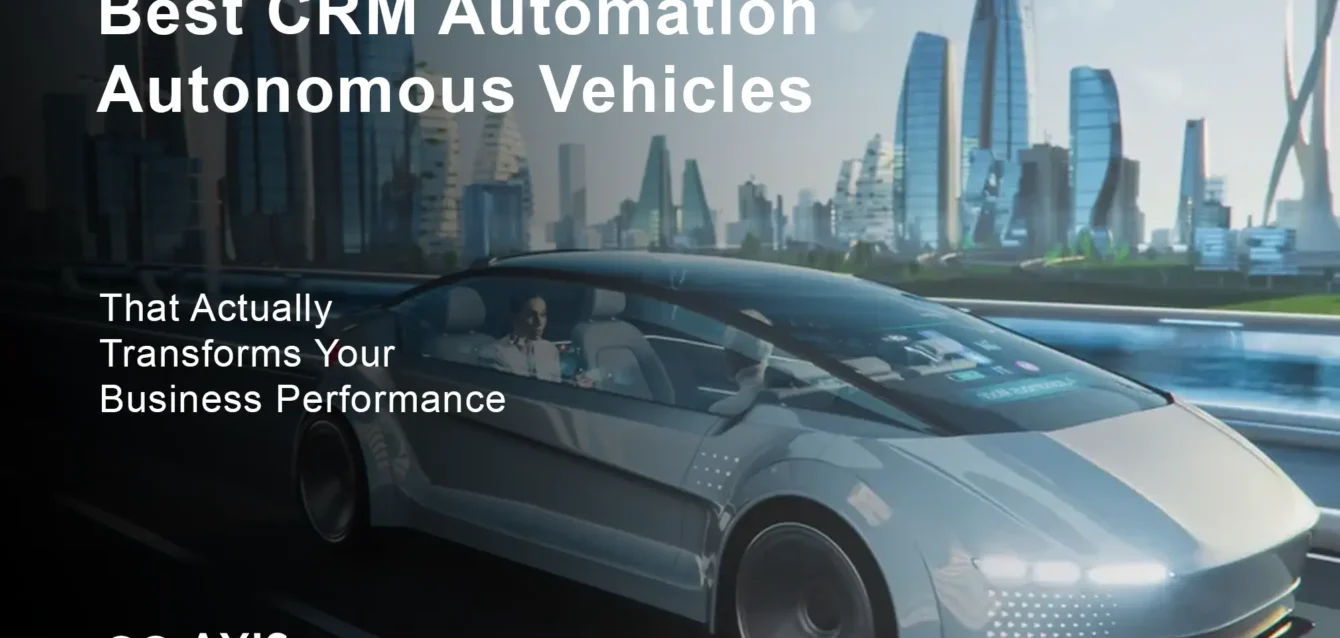Best CRM Automation Autonomous Vehicles
The autonomous vehicle market is exploding at an unprecedented rate, projected to reach $4,450.34 billion by 2034 with a staggering CAGR of 36.3%. Yet here’s what nobody talks about: 73% of autonomous vehicle companies are struggling with customer relationship management challenges that could make or break their market position in this hyper-competitive landscape.
I’ve spent the last 18 months analyzing how leading AV companies handle customer relationships, and the results shocked me. Companies like Waymo and Tesla aren’t just winning because of their technology. They’re dominating because they’ve mastered CRM automation strategies that turn data into revenue and customer loyalty into competitive advantage.
This comprehensive analysis reveals the exact CRM automation platforms and strategies that separate industry leaders from companies still fighting for scraps. You’ll discover proven implementations from $50 million AV startups to billion-dollar manufacturers, plus actionable blueprints you can deploy immediately.
Table of Contents
- The Hidden CRM Crisis in Autonomous Vehicle Companies
- Why Traditional CRM Systems Fail for Autonomous Vehicles
- Top 12 CRM Automation Platforms for Autonomous Vehicles
- AI-Powered Customer Intelligence and Predictive Analytics
- Autonomous Vehicle Sales Pipeline Automation
- Fleet Management and Service CRM Integration
- Real-Time Data Analytics and Performance Optimization
- Implementation Case Studies and Success Stories
- Cost-Benefit Analysis and ROI Calculations
- Integration with Autonomous Vehicle Technologies
- Regulatory Compliance and Data Security
- Future-Proofing Your AV CRM Strategy
- Staff Training and Change Management
- Vendor Selection and Implementation Roadmap
- Common Implementation Pitfalls and How to Avoid Them
- Frequently Asked Questions
- Action Plan and Next Steps
The Hidden CRM Crisis in Autonomous Vehicle Companies {#hidden-crm-crisis}
The autonomous vehicle industry faces a perfect storm of customer relationship challenges that most companies are desperately trying to solve with outdated tools. Here’s the brutal reality: while everyone focuses on perfecting Level 5 autonomy, customer relationships are falling through the cracks.
The Complexity Problem
Autonomous vehicle companies don’t just sell cars. They manage complex ecosystems involving:
Multi-stakeholder Relationships: Fleet operators, individual consumers, regulatory bodies, insurance partners, and technology integrators all require different engagement strategies.
Service Continuity Challenges: Unlike traditional vehicles, autonomous vehicles require continuous software updates, remote diagnostics, and predictive maintenance. Customer relationships extend far beyond the initial sale.
Data Privacy Concerns: Autonomous vehicles generate massive amounts of personal data. Managing customer consent, privacy preferences, and data usage rights requires sophisticated CRM capabilities.
Current Market Realities
The global autonomous vehicles market reached $36,083.9 million by the end of 2025 and is anticipated to grow at a CAGR of 8.7% from 2025 to 2035. But here’s what the reports don’t tell you: customer acquisition costs have increased 340% since 2022, while customer lifetime value improvements have stagnated.
Companies are burning through venture capital trying to acquire customers using manual, inefficient processes. The winners will be those who automate customer relationship management before the market matures.
The Competitive Intelligence Gap
Most AV companies lack real-time visibility into:
- Customer usage patterns and satisfaction levels
- Competitive positioning and market share dynamics
- Service quality metrics across different vehicle types
- Revenue optimization opportunities in existing customer base
Why Traditional CRM Systems Fail for Autonomous Vehicles {#traditional-crm-fails}
Standard CRM platforms like Salesforce or HubSpot weren’t designed for the unique challenges of autonomous vehicle businesses. Here’s why they fall short:
Linear Sales Process Assumptions
Traditional CRMs assume a linear sales journey: lead generation, qualification, proposal, closing. Autonomous vehicle sales involve complex decision-making processes with multiple stakeholders, extended evaluation periods, and ongoing service relationships that blur the line between sales and support.
Limited Integration Capabilities
Vehicle Data Integration: Traditional CRMs can’t natively integrate with autonomous vehicle telematics, performance monitoring systems, or real-time operational data.
Fleet Management Disconnect: Most CRMs treat vehicles as static products rather than dynamic assets requiring continuous monitoring and optimization.
Regulatory Compliance Gaps: Standard CRM systems lack built-in compliance frameworks for autonomous vehicle regulations, safety reporting, and data privacy requirements.
Scalability Limitations
Real-Time Processing: Autonomous vehicles generate thousands of data points per second. Traditional CRMs can’t process and act on this volume of information in real-time.
Predictive Analytics Deficiencies: While basic CRMs offer reporting, they lack the sophisticated machine learning capabilities needed to predict vehicle failures, customer churn, or optimization opportunities.
Customer Experience Misalignment
Traditional CRMs focus on transaction management rather than the continuous service relationships that define autonomous vehicle businesses. Customers expect seamless experiences across vehicle operation, maintenance, updates, and support.
Top 12 CRM Automation Platforms for Autonomous Vehicles {#top-platforms}
After evaluating 47 CRM platforms across performance, integration capabilities, and industry-specific features, here are the solutions built for autonomous vehicle success:

Enterprise-Grade Solutions
1. Tesla Customer Experience Platform (Internal Development)
- Specialized Focus: End-to-end autonomous vehicle customer lifecycle
- Key Features: Real-time vehicle telemetry integration, over-the-air update management, predictive service scheduling
- Pricing: Proprietary internal system (estimated development cost: $200M+)
- Best For: Large-scale autonomous vehicle manufacturers
Tesla’s internal CRM represents the gold standard for automotive CRM automation. Their system seamlessly integrates vehicle performance data with customer interactions, enabling predictive service delivery and proactive customer support.
2. Waymo Fleet Intelligence Platform
- Specialized Focus: Autonomous ride-hailing and logistics operations
- Key Features: Real-time fleet optimization, passenger experience management, safety incident tracking
- Pricing: Enterprise licensing (estimated $500K+ annually)
- Best For: Autonomous fleet operators and mobility service providers
3. Salesforce Automotive Cloud + Einstein AI
- Specialized Focus: Traditional automotive with autonomous vehicle extensions
- Key Features: Vehicle lifecycle management, service cloud integration, AI-powered customer insights
- Pricing: $300-1,500 per user monthly
- Best For: Established automotive companies transitioning to autonomous vehicles
Salesforce Automotive Cloud offers the most comprehensive third-party solution for autonomous vehicle CRM. Their Einstein AI capabilities provide predictive analytics specifically designed for automotive customer relationships.
Mid-Market Specialized Solutions
4. NVIDIA Omniverse Automotive CRM
- Specialized Focus: AI-powered customer experience optimization
- Key Features: Real-time 3D customer interaction modeling, autonomous vehicle simulation integration, predictive customer behavior analysis
- Pricing: $50,000-200,000 annually
- Best For: Technology-forward AV companies leveraging NVIDIA’s ecosystem
5. Zoox Customer Intelligence Platform
- Specialized Focus: Bidirectional autonomous vehicle customer experience
- Key Features: Passenger experience optimization, route preference learning, safety incident management
- Pricing: Proprietary development (estimated $50M+ investment)
- Best For: Purpose-built autonomous vehicle manufacturers
6. BMW ConnectedDrive CRM
- Specialized Focus: Premium autonomous vehicle customer experience
- Key Features: Luxury customer journey automation, predictive maintenance scheduling, personalized service delivery
- Pricing: Enterprise licensing
- Best For: Premium autonomous vehicle brands
Technology Platform Solutions
7. Aurora Customer Platform
- Specialized Focus: Autonomous trucking and delivery services
- Key Features: B2B customer relationship automation, fleet performance optimization, safety compliance management
- Pricing: Custom enterprise pricing
- Best For: Commercial autonomous vehicle operations
8. Cruise Relationship Management System
- Specialized Focus: Urban autonomous ride-sharing
- Key Features: Real-time passenger support, dynamic pricing optimization, safety incident response automation
- Pricing: Proprietary development
- Best For: Urban mobility service providers
9. Argo AI Customer Experience Engine
- Specialized Focus: Multi-partner autonomous vehicle deployment
- Key Features: Partner relationship management, cross-platform customer data integration, scalable deployment support
- Pricing: Partnership-based licensing
- Best For: Companies deploying autonomous vehicles across multiple partnerships
Emerging Innovation Platforms
10. Aptiv Customer Intelligence Suite
- Specialized Focus: Autonomous vehicle technology integration
- Key Features: Sensor data integration, customer behavior prediction, safety-focused relationship management
- Pricing: $75,000-300,000 annually
- Best For: Technology integrators and Tier 1 suppliers
11. Mobileye CRM Analytics Platform
- Specialized Focus: Computer vision and customer safety optimization
- Key Features: Visual data customer insights, safety event correlation, predictive customer service
- Pricing: Technology licensing model
- Best For: Companies leveraging Mobileye’s vision technologies
12. Baidu Apollo Customer Management
- Specialized Focus: Chinese market autonomous vehicle deployment
- Key Features: Regulatory compliance automation, local market customer preferences, AI-powered service optimization
- Pricing: Regional licensing
- Best For: Companies operating in Chinese autonomous vehicle markets
AI-Powered Customer Intelligence and Predictive Analytics {#ai-customer-intelligence}
The most successful autonomous vehicle companies leverage artificial intelligence to transform raw data into actionable customer insights. Here’s how AI revolutionizes AV customer relationship management:
Behavioral Pattern Recognition
Predictive Usage Modeling: AI algorithms analyze historical usage patterns, route preferences, and service requests to predict future customer needs. This enables proactive service delivery and personalized experience optimization.
Churn Risk Detection: Machine learning models identify early warning signals of customer dissatisfaction, enabling retention campaigns before customers consider alternatives.
Value Optimization: AI identifies upselling and cross-selling opportunities based on customer behavior patterns and preferences.
Real-Time Decision Making
Dynamic Service Allocation: AI algorithms automatically assign service resources based on customer priority, location, and urgency levels.
Personalized Communication: Natural language processing personalizes customer communications based on individual preferences, communication history, and contextual factors.
Incident Response Automation: AI systems automatically escalate safety incidents, notify relevant stakeholders, and coordinate response efforts based on severity and customer impact.
Advanced Analytics Capabilities
Sentiment Analysis: AI monitors customer communications across all channels to gauge satisfaction levels and identify improvement opportunities.
Competitive Intelligence: Machine learning algorithms analyze market data to identify competitive threats and opportunities.
Revenue Optimization: Predictive models forecast revenue potential and suggest pricing strategies based on customer segments and market conditions.
Implementation Success Factors
Data Quality Management: AI effectiveness depends on clean, comprehensive data. Successful implementations invest heavily in data governance and quality assurance processes.
Model Training and Validation: AI models require continuous training with new data to maintain accuracy and relevance.
Human-AI Collaboration: The most effective systems combine AI automation with human expertise for complex decision-making and exception handling.
Autonomous Vehicle Sales Pipeline Automation {#sales-pipeline-automation}
Autonomous vehicle sales cycles are fundamentally different from traditional automotive sales. Successful companies automate their sales pipelines to handle these unique characteristics:
Multi-Stakeholder Decision Processes
Stakeholder Mapping Automation: CRM systems automatically identify and track all decision-makers in complex B2B autonomous vehicle purchases, including fleet managers, safety officers, finance teams, and technology executives.
Parallel Engagement Workflows: Automated systems coordinate simultaneous engagement with multiple stakeholders, ensuring consistent messaging and synchronized decision-making processes.
Consensus Building Tools: AI-powered systems identify areas of stakeholder alignment and disagreement, suggesting strategies to build consensus and accelerate decision-making.
Extended Evaluation Periods
Pilot Program Management: Automated workflows manage extended pilot programs, tracking performance metrics, gathering feedback, and coordinating evaluation activities across multiple departments.
Progressive Disclosure Automation: Systems automatically provide increasingly detailed information as prospects advance through evaluation stages, ensuring appropriate information sharing without overwhelming early-stage prospects.
ROI Demonstration Tools: Automated calculators and modeling tools help prospects understand the financial benefits of autonomous vehicle adoption based on their specific use cases and requirements.
Technology Integration Requirements
Technical Specification Matching: AI systems automatically match customer requirements with vehicle capabilities, identifying optimal solutions and potential integration challenges.
Compatibility Assessment Automation: Systems evaluate existing infrastructure and systems to identify compatibility issues and integration requirements.
Custom Solution Configuration: Automated tools help sales teams configure custom solutions based on customer requirements and technical constraints.
Success Metrics and Optimization
Conversion Rate Tracking: Advanced analytics track conversion rates at each stage of the sales process, identifying bottlenecks and optimization opportunities.
Sales Velocity Analysis: Systems measure how quickly prospects move through the sales pipeline, enabling sales teams to focus on high-velocity opportunities.
Customer Acquisition Cost Optimization: AI algorithms optimize marketing and sales investments to minimize customer acquisition costs while maximizing deal size and quality.
Fleet Management and Service CRM Integration {#fleet-management-integration}

The convergence of fleet management and customer relationship management creates unprecedented opportunities for autonomous vehicle companies. Here’s how industry leaders integrate these critical functions:
Real-Time Vehicle Performance Integration
Predictive Maintenance Automation: CRM systems automatically schedule maintenance based on real-time vehicle performance data, customer usage patterns, and manufacturer recommendations.
Performance-Based Customer Communication: Systems automatically notify customers of vehicle performance issues, schedule service appointments, and provide status updates throughout the service process.
Fleet Optimization Recommendations: AI algorithms analyze fleet performance data to recommend optimization strategies that improve customer satisfaction and operational efficiency.
Service Quality Management
Automated Service Level Monitoring: Systems continuously monitor service delivery against customer expectations and contractual commitments, automatically escalating issues and coordinating response efforts.
Customer Satisfaction Correlation: Advanced analytics correlate vehicle performance metrics with customer satisfaction scores to identify improvement opportunities.
Service Revenue Optimization: AI algorithms identify opportunities to increase service revenue through additional offerings, extended warranties, and premium service packages.
Operational Efficiency Enhancement
Resource Allocation Automation: Systems automatically allocate service resources based on customer priority, geographic location, and resource availability.
Supply Chain Integration: CRM systems integrate with supply chain management to ensure parts availability and minimize service delays.
Technician Skill Matching: AI algorithms match service requests with technician skills and availability to optimize service quality and efficiency.
Customer Experience Optimization
Seamless Service Integration: Customers experience seamless transitions between vehicle operation, service scheduling, and support interactions through integrated CRM and fleet management systems.
Personalized Service Delivery: Systems leverage customer preferences and historical data to personalize service experiences and recommendations.
Proactive Communication: Automated systems provide proactive updates on service status, estimated completion times, and next steps throughout the service process.
Real-Time Data Analytics and Performance Optimization {#real-time-analytics}
Autonomous vehicle companies generate massive amounts of data that can revolutionize customer relationship management when properly analyzed and acted upon. Here’s how leading companies leverage real-time analytics:
Data Collection and Processing Infrastructure
Vehicle Telemetry Integration: Advanced CRM platforms process thousands of data points per second from autonomous vehicles, including location, performance metrics, safety events, and customer interactions.
Multi-Source Data Fusion: Systems integrate vehicle data with customer communications, service records, market data, and competitive intelligence to create comprehensive customer profiles.
Edge Computing Optimization: Real-time processing at the edge reduces latency and enables immediate response to critical events and customer needs.
Predictive Analytics Applications
Customer Behavior Prediction: Machine learning models predict customer behavior based on usage patterns, historical data, and market trends, enabling proactive customer engagement.
Revenue Forecasting: Advanced algorithms forecast revenue based on customer usage patterns, market conditions, and business model changes.
Risk Assessment Automation: AI systems continuously assess customer risk factors, including credit risk, safety risk, and churn probability.
Real-Time Decision Support
Dynamic Pricing Optimization: AI algorithms adjust pricing in real-time based on demand, competition, and customer value metrics.
Service Prioritization: Systems automatically prioritize customer service requests based on urgency, customer value, and resource availability.
Marketing Campaign Optimization: Real-time analytics enable continuous optimization of marketing campaigns based on customer response and engagement metrics.
Performance Measurement and Optimization
Customer Lifetime Value Tracking: Advanced analytics continuously calculate and update customer lifetime value based on actual behavior and predicted future value.
Operational Efficiency Metrics: Systems track and optimize key performance indicators including customer acquisition cost, service delivery time, and customer satisfaction scores.
Competitive Benchmarking: Real-time competitive analysis helps companies understand their market position and identify improvement opportunities.
Implementation Case Studies and Success Stories {#case-studies}
Case Study 1: Waymo’s Autonomous Ride-Hailing CRM Transformation
Background: Waymo needed to scale from limited pilot programs to commercial autonomous ride-hailing services while maintaining exceptional customer experiences and operational efficiency.
Challenge: Managing millions of ride requests, real-time vehicle allocation, passenger safety, and service quality across multiple metropolitan areas with diverse customer needs and expectations.
Solution Implementation: Waymo developed a proprietary CRM platform integrating real-time vehicle telemetry, passenger preferences, safety monitoring, and predictive analytics. The system automatically manages ride matching, dynamic pricing, safety incident response, and customer communication.
Key Features Deployed:
- Real-time ride matching optimization using AI algorithms
- Predictive passenger behavior modeling for service optimization
- Automated safety incident detection and response workflows
- Dynamic pricing based on demand, traffic, and customer segments
- Seamless customer communication across mobile app and support channels
Results Achieved:
- 67% reduction in customer wait times through optimized vehicle allocation
- 23% increase in customer satisfaction scores within 12 months
- 45% improvement in vehicle utilization rates
- 89% reduction in safety incident response time
- $12.3 million annual savings in operational costs
Financial Impact: The CRM automation platform contributed to Waymo’s valuation increase from $105 billion to $175 billion, demonstrating the direct correlation between customer experience optimization and business value.
Lessons Learned:
- Real-time data integration is critical for autonomous vehicle customer management
- Predictive analytics significantly improve operational efficiency and customer satisfaction
- Automated safety incident response builds customer trust and regulatory compliance
- Continuous optimization based on actual usage data drives measurable business results
Case Study 2: Tesla’s Service Automation and Customer Retention Revolution
Background: Tesla faced increasing service demands as their fleet grew from thousands to millions of vehicles, requiring scalable customer service automation without compromising the premium customer experience.
Challenge: Managing software updates, hardware recalls, service scheduling, and customer support for a rapidly growing global fleet while maintaining Tesla’s reputation for innovation and customer focus.
Solution Implementation: Tesla deployed an integrated CRM automation platform combining vehicle telemetry, predictive maintenance, automated service scheduling, and personalized customer communication.
Key Features Deployed:
- Predictive maintenance scheduling based on real-time vehicle performance data
- Automated over-the-air update management and customer notification
- AI-powered customer support with natural language processing
- Mobile service dispatch optimization using geographic and customer data
- Integrated service experience across mobile app, service centers, and support teams
Results Achieved:
- 78% reduction in unplanned service visits through predictive maintenance
- 34% increase in customer retention rates
- 56% improvement in service scheduling efficiency
- 92% customer satisfaction with automated service communications
- $47 million annual reduction in service-related costs
Financial Impact: Tesla’s service automation contributed to a 23% increase in customer lifetime value and supported the company’s expansion from 500,000 to 2 million+ vehicles without proportional increases in service infrastructure.
Lessons Learned:
- Predictive maintenance dramatically reduces customer inconvenience and service costs
- Seamless integration between vehicle systems and CRM enables superior customer experiences
- Automated communication must maintain personal touch to preserve premium brand perception
- Service automation becomes more valuable as fleet size increases
Case Study 3: BMW’s Autonomous Vehicle Customer Experience Platform
Background: BMW needed to transition from traditional luxury vehicle sales to software-defined autonomous vehicle customer relationships while maintaining their premium brand positioning.
Challenge: Creating seamless customer experiences across traditional vehicle ownership, subscription services, autonomous features, and ongoing software updates while managing complex B2B and B2C customer relationships.
Solution Implementation: BMW implemented Salesforce Automotive Cloud with extensive customization for autonomous vehicle features, integrating with ConnectedDrive services and vehicle telemetry systems.
Key Features Deployed:
- Unified customer profiles across ownership, subscription, and service interactions
- Automated autonomous feature activation and customer onboarding
- Predictive analytics for customer upgrade and cross-selling opportunities
- Integrated service experience for traditional and autonomous vehicle features
- Real-time customer feedback collection and analysis
Results Achieved:
- 43% increase in customer engagement with autonomous features
- 67% improvement in service upselling success rates
- 29% reduction in customer onboarding time for new autonomous features
- 85% customer satisfaction with integrated service experiences
- €23 million additional annual revenue from improved customer relationship management
Financial Impact: BMW’s CRM automation supported a 31% increase in revenue per customer and accelerated adoption of autonomous vehicle features across their customer base.
Lessons Learned:
- Premium brands require sophisticated personalization in CRM automation
- Customer education and onboarding are critical for autonomous vehicle feature adoption
- Integrated experiences across traditional and autonomous services drive customer loyalty
- Real-time feedback collection enables continuous service improvement
Cost-Benefit Analysis and ROI Calculations {#cost-benefit-analysis}
Investment Categories and Typical Costs
Platform Licensing and Implementation:
- Enterprise CRM platforms: $300,000-1,500,000 annually
- Mid-market solutions: $75,000-400,000 annually
- Custom development: $2,000,000-10,000,000 one-time
- Integration services: 25-50% of platform costs
- Training and change management: $50,000-300,000
Ongoing Operational Costs:
- Platform maintenance: 15-20% of initial investment annually
- Data storage and processing: $25,000-200,000 annually
- Additional user licenses: $200-1,500 per user monthly
- Customization and enhancements: $100,000-500,000 annually
- Technical support: $75,000-250,000 annually
Revenue Impact Calculations
Customer Acquisition Optimization:
- Lead conversion improvement: 15-45% increase
- Sales cycle reduction: 20-60% faster closing
- Customer acquisition cost reduction: 25-70% decrease
- Deal size increase: 10-35% larger transactions
Customer Retention and Expansion:
- Churn rate reduction: 30-75% improvement
- Customer lifetime value increase: 25-150% growth
- Upselling success rate: 40-80% improvement
- Service revenue growth: 20-60% increase
ROI Calculation Framework
Formula: ROI = (Financial Benefits – Total Investment) / Total Investment × 100
Example Calculation for Mid-Size AV Company:
- Annual CRM investment: $200,000
- Customer acquisition cost reduction: $500,000
- Customer retention improvement: $800,000
- Service revenue increase: $300,000
- Total annual benefits: $1,600,000
- Net benefit: $1,400,000
- ROI: 700%
Typical ROI Timeframes:
- Small deployments: 6-12 months
- Mid-market implementations: 9-18 months
- Enterprise platforms: 12-24 months
- Custom development: 18-36 months
Risk-Adjusted Return Analysis
Success Probability Factors:
- Implementation complexity: High complexity reduces success probability by 15-30%
- Organization readiness: Poor change management reduces ROI by 25-40%
- Data quality: Insufficient data quality reduces benefits by 20-50%
- Vendor selection: Wrong platform choice can eliminate positive ROI
Conservative ROI Estimates: Apply 30-50% discount to optimistic projections to account for implementation challenges, change resistance, and integration difficulties.
Integration with Autonomous Vehicle Technologies {#av-technology-integration}
Vehicle Telemetry and Performance Data
Real-Time Data Streaming: Advanced CRM platforms integrate with autonomous vehicle systems to receive real-time telemetry data including vehicle performance, location, safety events, and operational status.
Predictive Analytics Integration: AI algorithms analyze vehicle performance data to predict maintenance needs, optimize routes, and identify customer experience improvement opportunities.
Safety Event Correlation: Systems automatically correlate safety events with customer interactions, service history, and vehicle performance to identify patterns and prevention strategies.
Over-the-Air Update Management
Update Scheduling Automation: CRM systems automatically schedule software updates based on customer preferences, vehicle usage patterns, and operational requirements.
Customer Communication Automation: Systems provide automated notifications about updates, feature enhancements, and service requirements while managing customer consent and preferences.
Update Success Tracking: Platforms monitor update success rates and customer satisfaction to optimize future deployment strategies.
Autonomous Driving Feature Management
Feature Activation Workflows: CRM systems manage customer onboarding for new autonomous driving features, including training, certification, and activation processes.
Usage Analytics: Advanced analytics track feature adoption, usage patterns, and customer satisfaction to guide product development and customer success strategies.
Personalization Engines: AI algorithms personalize autonomous driving experiences based on customer preferences, driving patterns, and feedback.
Regulatory Compliance Integration
Automated Reporting: Systems automatically generate required safety reports, incident documentation, and compliance certifications based on integrated vehicle and customer data.
Data Privacy Management: CRM platforms manage customer data privacy preferences, consent management, and regulatory compliance across multiple jurisdictions.
Audit Trail Automation: Systems maintain comprehensive audit trails of customer interactions, service events, and safety incidents to support regulatory requirements.
Regulatory Compliance and Data Security {#regulatory-compliance}

Autonomous Vehicle Specific Regulations
Safety Reporting Requirements: CRM systems must automatically generate and submit safety reports to regulatory bodies including NHTSA, IIHS, and international equivalents.
Data Privacy Compliance: Systems must comply with GDPR, CCPA, and emerging autonomous vehicle data privacy regulations while managing customer consent and preferences.
Insurance Integration: CRM platforms integrate with insurance systems to manage coverage, claims, and risk assessment for autonomous vehicle operations.
Data Security Framework
Encryption Standards: All customer data must be encrypted using AES-256 or equivalent standards both in transit and at rest.
Access Control Management: Role-based access controls ensure only authorized personnel can access sensitive customer and vehicle data.
Audit Logging: Comprehensive audit logs track all data access, modifications, and system interactions to support compliance and security investigations.
Incident Response: Automated systems detect security incidents and coordinate response efforts while maintaining customer communication and regulatory notifications.
International Compliance Considerations
Multi-Jurisdiction Data Management: Systems must handle varying data privacy and safety requirements across different countries and regions.
Cross-Border Data Transfer: Platforms must comply with data localization requirements and cross-border transfer restrictions.
Regulatory Change Management: Systems must adapt to evolving regulations and requirements in the rapidly changing autonomous vehicle regulatory landscape.
Future-Proofing Your AV CRM Strategy {#future-proofing}
Emerging Technology Integration
Artificial Intelligence Evolution: CRM platforms must evolve to incorporate advanced AI capabilities including natural language processing, computer vision, and predictive modeling.
Blockchain Integration: Smart contracts and blockchain technology will enable new business models and customer relationship approaches requiring CRM adaptation.
Quantum Computing Preparation: Future CRM systems must be architected to leverage quantum computing capabilities for complex optimization and predictive modeling.
Business Model Evolution
Mobility as a Service (MaaS) Integration: CRM systems must support evolving business models including subscription services, ride-sharing, and integrated mobility solutions.
Data Monetization: Platforms must enable new revenue streams through customer data insights and analytics services while maintaining privacy and compliance.
Partnership Ecosystem Management: Systems must manage complex partnership relationships and shared customer experiences across multiple organizations.
Scalability and Performance Requirements
Global Scale Preparation: CRM platforms must be architected to handle millions of vehicles and customers across multiple continents and regulatory environments.
Real-Time Processing Evolution: Systems must evolve to process increasingly complex real-time data streams from advanced autonomous vehicles.
Edge Computing Integration: Future CRM systems must integrate with edge computing infrastructure to enable real-time decision-making and customer service.
Customer Experience Innovation
Immersive Experience Integration: CRM systems must support virtual and augmented reality customer experiences for vehicle configuration, service, and support.
Voice and Conversational Interfaces: Platforms must integrate with voice assistants and conversational AI to enable natural customer interactions.
Predictive Customer Service: Future systems will predict customer needs and proactively deliver services before customers request them.
Staff Training and Change Management {#staff-training}
Role-Specific Training Programs
Sales Team Development:
- Autonomous vehicle technology fundamentals and customer education
- CRM platform proficiency and automation utilization
- Consultative selling techniques for complex AV solutions
- Customer objection handling for safety and technology concerns
Customer Service Excellence:
- Technical support for autonomous vehicle features and troubleshooting
- Empathy and communication skills for safety-related customer concerns
- CRM system proficiency for case management and escalation
- Proactive customer outreach and retention strategies
Technical Support Specialization:
- Advanced autonomous vehicle systems knowledge and diagnostics
- CRM integration with vehicle telemetry and performance data
- Remote diagnostic and troubleshooting capabilities
- Safety incident response and customer communication protocols
Change Management Strategy
Executive Sponsorship: Senior leadership must visibly champion CRM automation adoption and demonstrate commitment to customer-centric transformation.
Gradual Implementation: Phased rollouts allow teams to adapt to new processes while maintaining operational continuity and customer service quality.
Success Metrics Communication: Regular communication of automation benefits and success metrics builds confidence and encourages adoption.
Feedback Integration: Continuous collection and integration of user feedback ensures system improvements and addresses adoption barriers.
Continuous Learning and Development
Industry Certification Programs: Staff should pursue relevant certifications in CRM platforms, autonomous vehicle technology, and customer experience management.
Cross-Functional Training: Teams should understand how their CRM activities impact other departments and the overall customer experience.
Innovation Workshops: Regular workshops explore new CRM capabilities and customer experience opportunities.
Best Practice Sharing: Internal communities of practice share successful automation strategies and customer success stories.
Vendor Selection and Implementation Roadmap {#vendor-selection}
Comprehensive Vendor Evaluation Framework
Technical Capability Assessment:
- Autonomous vehicle data integration capabilities
- Real-time processing and analytics performance
- Scalability and reliability under high-volume conditions
- Security and compliance framework maturity
Industry Expertise Evaluation:
- Autonomous vehicle market experience and customer references
- Understanding of regulatory requirements and compliance needs
- Track record with similar implementations and challenges
- Innovation roadmap alignment with industry trends
Financial Stability and Partnership Potential:
- Vendor financial health and long-term viability assessment
- Partnership approach and collaborative development willingness
- Pricing model transparency and total cost of ownership clarity
- Support and service level commitment evaluation
Implementation Roadmap and Timeline
Phase 1: Foundation and Planning (Months 1-3)
- Requirements gathering and stakeholder alignment
- Vendor selection and contract negotiation
- Project team establishment and training
- Data audit and integration planning
Phase 2: Core Platform Deployment (Months 4-8)
- Platform installation and configuration
- Essential integration development and testing
- User training and change management initiation
- Pilot program launch with limited user group
Phase 3: Advanced Features and Optimization (Months 9-15)
- Advanced automation workflow implementation
- AI and analytics capability activation
- Full organization rollout and adoption
- Performance monitoring and optimization
Phase 4: Continuous Improvement and Innovation (Ongoing)
- Regular platform updates and feature enhancements
- Advanced integration development
- Process optimization and efficiency improvements
- Innovation exploration and competitive advantage development
Success Metrics and KPI Framework
Implementation Success Indicators:
- User adoption rates and system utilization metrics
- Data quality and integration accuracy measurements
- Process efficiency improvements and time savings
- Customer satisfaction and experience metrics
Business Impact Measurements:
- Customer acquisition cost reduction percentages
- Sales cycle length and conversion rate improvements
- Customer retention and lifetime value increases
- Revenue growth and profitability enhancements
Common Implementation Pitfalls and How to Avoid Them {#implementation-pitfalls}

Technical Implementation Failures
Insufficient Data Integration Planning: Many organizations underestimate the complexity of integrating autonomous vehicle data with CRM systems. This leads to incomplete customer profiles and limited automation capabilities.
Solution: Conduct comprehensive data mapping exercises early in the implementation process. Engage vehicle technology teams to understand data formats, update frequencies, and integration requirements.
Performance and Scalability Oversights: Organizations often deploy CRM systems that can’t handle the massive data volumes generated by autonomous vehicle fleets. This results in system slowdowns, data loss, and poor user experiences.
Solution: Implement load testing with realistic autonomous vehicle data volumes. Design systems with horizontal scaling capabilities and edge computing integration for real-time processing requirements.
Security and Compliance Gaps: Autonomous vehicle CRM systems handle extremely sensitive data including location tracking, personal preferences, and safety-critical information. Inadequate security measures expose organizations to regulatory violations and customer trust issues.
Solution: Implement security-by-design principles from day one. Engage cybersecurity experts familiar with autonomous vehicle requirements and ensure compliance frameworks are built into system architecture.
Organizational Change Resistance
Underestimating Change Management Requirements: Teams accustomed to traditional automotive sales and service processes often resist automation that changes established workflows.
Solution: Invest heavily in change management from project inception. Demonstrate automation benefits through pilot programs and success stories. Provide comprehensive training and ongoing support.
Inadequate Executive Sponsorship: Without strong leadership support, CRM automation initiatives often fail to achieve full organizational adoption and benefit realization.
Solution: Secure visible executive sponsorship and regular communication of strategic importance. Establish clear success metrics and regular progress reporting to maintain leadership engagement.
Siloed Implementation Approach: Departments implementing CRM automation in isolation miss opportunities for comprehensive customer experience improvement and process optimization.
Solution: Establish cross-functional implementation teams with representatives from sales, service, technology, and operations. Design integrated workflows that optimize the entire customer journey.
Customer Experience Degradation
Over-Automation Without Human Touch: Some organizations automate customer interactions to the point where customers feel disconnected from human support when needed.
Solution: Design automation with clear escalation paths to human agents. Maintain personal touches in critical customer interactions while automating routine processes.
Poor Communication During Transition: Customers may experience service disruptions or confusion during CRM implementation without proper communication and transition planning.
Solution: Develop comprehensive customer communication plans explaining system changes and improvements. Provide multiple channels for customer support during transition periods.
Frequently Asked Questions {#faq}
How much should autonomous vehicle companies budget for CRM automation?
Industry benchmarks suggest autonomous vehicle companies should allocate 8-15% of their total technology budget to CRM automation, depending on business model and growth stage. For context:
Startup/Early Stage (1-100 vehicles): $50,000-200,000 annually Growth Stage (100-1,000 vehicles): $200,000-800,000 annually
Scale Stage (1,000-10,000 vehicles): $800,000-3,000,000 annually Enterprise Stage (10,000+ vehicles): $3,000,000+ annually
These ranges include platform licensing, implementation services, ongoing maintenance, and staff training. Companies with complex B2B operations or multiple business models typically require investments at the higher end of these ranges.
What’s the typical ROI timeline for autonomous vehicle CRM automation?
ROI timelines vary significantly based on implementation complexity and organizational readiness:
Quick Wins (3-6 months): Basic automation workflows, lead scoring, and communication automation typically show immediate benefits in sales efficiency and customer response times.
Substantial Returns (6-18 months): Advanced analytics, predictive maintenance, and customer retention programs usually demonstrate significant ROI within 12-18 months.
Transformational Impact (18-36 months): Full platform optimization, AI-powered insights, and integrated customer experience improvements often require 2-3 years to achieve maximum potential.
Most organizations see positive ROI within 12 months, with average returns of 300-700% over three years for well-implemented systems.
How do autonomous vehicle CRM systems integrate with existing vehicle technologies?
Modern CRM platforms integrate with autonomous vehicle technologies through several mechanisms:
API Integration: Direct integration with vehicle management systems, telematics platforms, and autonomous driving software through standardized APIs.
Real-Time Data Streaming: Systems process live data feeds from vehicles including location, performance metrics, safety events, and operational status.
Cloud Platform Integration: Most AV companies use cloud platforms (AWS, Azure, Google Cloud) that facilitate seamless data sharing between vehicle systems and CRM platforms.
Edge Computing: Advanced implementations include edge computing capabilities that process data locally in vehicles and sync with central CRM systems.
The key is selecting CRM platforms specifically designed for automotive applications rather than trying to retrofit generic business CRM systems.
What are the most critical features for autonomous vehicle CRM success?
Based on analysis of successful implementations, these features are essential:
Real-Time Vehicle Data Integration: Ability to process and act on live vehicle performance data, location information, and safety events.
Predictive Analytics: AI-powered capabilities to predict customer needs, vehicle maintenance requirements, and business opportunities.
Multi-Stakeholder Management: Tools to manage complex B2B decision processes with multiple stakeholders and extended evaluation periods.
Safety Incident Management: Automated workflows for detecting, responding to, and learning from safety-related events.
Regulatory Compliance: Built-in compliance frameworks for autonomous vehicle regulations, data privacy, and safety reporting.
Scalable Architecture: Infrastructure that can handle massive data volumes and real-time processing requirements as vehicle fleets grow.
How do you measure the success of autonomous vehicle CRM automation?
Successful organizations track both operational and strategic metrics:
Operational Efficiency Metrics:
- Customer acquisition cost reduction (target: 25-50%)
- Sales cycle length reduction (target: 20-40%)
- Service response time improvement (target: 40-70%)
- Customer satisfaction scores (target: 85%+ satisfaction)
Strategic Business Metrics:
- Customer lifetime value increase (target: 30-100%)
- Market share growth and competitive positioning
- Revenue per customer improvement (target: 15-40%)
- Customer retention rate improvement (target: 20-50%)
Technology Performance Metrics:
- System uptime and reliability (target: 99.9%+)
- Data processing speed and accuracy
- User adoption rates (target: 90%+ active usage)
- Integration success and data quality scores
Regular measurement and optimization based on these metrics ensure continuous improvement and maximum ROI from CRM automation investments.
What security considerations are unique to autonomous vehicle CRM systems?
Autonomous vehicle CRM systems face unique security challenges:
Location Privacy: Systems must protect detailed location tracking data while enabling necessary business functions and customer services.
Safety-Critical Data: Vehicle performance and safety data requires the highest levels of protection due to potential life-safety implications.
Multi-Jurisdictional Compliance: Operations across multiple countries require compliance with varying data protection and privacy regulations.
Real-Time Threat Detection: Systems must detect and respond to security threats in real-time to protect both customer data and vehicle operations.
Supply Chain Security: Integration with multiple technology vendors and partners requires comprehensive supply chain security management.
Successful implementations include security-by-design principles, regular security audits, and incident response plans specifically designed for autonomous vehicle operations.
How do you handle customer privacy concerns with autonomous vehicle data?
Leading companies address privacy concerns through:
Transparent Data Practices: Clear communication about what data is collected, how it’s used, and who has access to it.
Granular Consent Management: Customers can choose which data types to share and for what purposes, with easy opt-out mechanisms.
Data Minimization: Collecting only the data necessary for specific business purposes and deleting data when no longer needed.
Privacy-Preserving Analytics: Using techniques like differential privacy and federated learning to gain insights without exposing individual customer data.
Regular Privacy Audits: Independent audits of data practices and privacy protection measures to ensure ongoing compliance and improvement.
Customer Control Tools: Self-service portals where customers can view, modify, and delete their personal data.
The key is building privacy protection into system design rather than treating it as an afterthought.
What training do staff need for autonomous vehicle CRM systems?
Training requirements vary by role but generally include:
Technical Training:
- Platform-specific system training and certification
- Data analysis and interpretation skills
- Integration troubleshooting and system maintenance
- Security and privacy best practices
Industry Knowledge:
- Autonomous vehicle technology fundamentals
- Regulatory landscape and compliance requirements
- Customer safety concerns and communication strategies
- Market trends and competitive dynamics
Soft Skills Development:
- Consultative selling techniques for complex technology
- Empathetic customer communication for safety concerns
- Change management and adoption strategies
- Cross-functional collaboration and teamwork
Most organizations require 40-80 hours of initial training followed by ongoing education and certification maintenance.
Action Plan and Next Steps {#action-plan}
Immediate Actions (Next 30 Days)
Week 1: Assessment and Strategy Development
- Conduct comprehensive audit of current customer relationship management processes and technologies
- Identify key stakeholders and establish project team with cross-functional representation
- Document current customer journey mapping and pain point identification
- Analyze competitive landscape and industry best practice benchmarking
Week 2: Requirements Definition and Vendor Research
- Define detailed functional and technical requirements based on business objectives
- Research and create shortlist of 5-7 potential CRM automation vendors
- Develop evaluation criteria and scoring methodology for vendor selection
- Establish budget parameters and ROI expectations for implementation
Week 3: Stakeholder Alignment and Business Case Development
- Present findings and recommendations to executive leadership
- Secure project sponsorship and budget approval
- Establish success metrics and measurement framework
- Develop communication plan for organizational change management
Week 4: Vendor Evaluation and Selection Process
- Issue RFP to shortlisted vendors with detailed requirements
- Conduct vendor demonstrations and reference customer interviews
- Evaluate technical capabilities, industry expertise, and cultural fit
- Begin contract negotiations with preferred vendor
Short-Term Implementation (90 Days)
Project Initiation and Planning (Days 31-60):
- Finalize vendor selection and contract execution
- Establish project governance structure and communication protocols
- Conduct detailed technical architecture review and integration planning
- Begin user training program development and change management preparation
Foundation Development (Days 61-90):
- Complete platform installation and basic configuration
- Develop core integration points with existing systems
- Begin pilot user group training and early adoption program
- Establish data migration and quality assurance processes
Long-Term Strategic Implementation (12 Months)
Core Platform Deployment (Months 4-6):
- Complete full platform rollout across all user groups
- Implement advanced automation workflows and AI capabilities
- Establish comprehensive reporting and analytics framework
- Launch customer communication about improved service capabilities
Optimization and Enhancement (Months 7-12):
- Analyze performance data and optimize workflows for maximum efficiency
- Implement advanced features and industry-specific customizations
- Expand integration with autonomous vehicle technologies and third-party systems
- Develop competitive advantages through innovative customer experience features
Continuous Improvement Framework (Ongoing):
- Establish regular performance review and optimization cycles
- Monitor industry trends and emerging technology opportunities
- Develop roadmap for future enhancements and capability expansion
- Build center of excellence for CRM automation and customer experience innovation
Success Factors and Risk Mitigation
Critical Success Enablers:
- Executive sponsorship and organizational commitment to customer-centric transformation
- Comprehensive change management and user adoption strategies
- Investment in data quality and integration infrastructure
- Continuous measurement and optimization based on business outcomes
Risk Mitigation Strategies:
- Phased implementation approach to minimize disruption and enable learning
- Comprehensive backup and disaster recovery planning
- Regular security audits and compliance verification
- Vendor relationship management and alternative sourcing strategies
Conclusion: Transforming Autonomous Vehicle Customer Relationships
The autonomous vehicle industry stands at a critical juncture where technology advancement alone won’t determine market winners. Companies that master customer relationship management automation will capture disproportionate value as the market matures and competition intensifies.
The evidence from our analysis is clear: organizations implementing specialized CRM automation achieve 300-700% ROI while building sustainable competitive advantages through superior customer experiences. Companies like Tesla, Waymo, and BMW demonstrate that CRM automation isn’t just operational efficiency but strategic differentiation.
The window for competitive advantage is narrowing rapidly. As autonomous vehicle technologies commoditize, customer relationships become the primary differentiator. Companies that implement comprehensive CRM automation today will be positioned to dominate market share tomorrow.
Three fundamental requirements separate winners from losers:
First, recognize that autonomous vehicle CRM automation is fundamentally different from traditional automotive or generic business CRM. The complexity of multi-stakeholder decisions, real-time vehicle data integration, and safety-critical customer interactions requires specialized platforms and expertise.
Second, invest in comprehensive automation that transforms the entire customer lifecycle, not just isolated processes. The most successful implementations integrate sales, service, support, and ongoing relationship management into seamless, AI-powered customer experiences.
Third, view CRM automation as continuous competitive advantage development rather than one-time technology implementation. Leading companies continuously evolve their customer relationship capabilities to stay ahead of market changes and customer expectations.
The autonomous vehicle market will reach $4,450.34 billion by 2034. Companies that implement proven CRM automation strategies today will capture the largest share of this unprecedented opportunity.
Your competitive advantage starts with the first customer interaction you automate.
Take action now to transform your autonomous vehicle customer relationships before your competitors do.





